SCHILLER INSTITUTE CONFERENCE
Building A World Land-Bridge:
Realizing Mankind's True Humanity
Thursday, April 7, 2016, 9:00am - 9:30pm
NEW YORK CITY
Panel 2: Science As Society's Unifying Mission -- "We Aren't Done Yet"
Jason Ross, leader of the LaRouche "Basement" Science Team
 Click to watch the Panel II video starting at 1h 18m 35s from the beginning with the introduction to Jason Ross's presentation. |
Program and video
Invitation
A PDF version of this article appears in the April 15, 2016 issue of Executive Intelligence Review and is re-published here with permission.
![]()
Download slides used in this presentation
as a Microsoft Power Point file (2.93 MB)
Dennis Speed: During the period 1999, 2000, 2001, LaRouche created something called the LaRouche Youth Movement. He insisted that the difference would be that among those people that he was recruiting at that time, there had to be a scientific rigor, a sense of the knowledge of the way that the world really works, because that was the only way to really understand economics. To that end, there was a years-long project that was undertaken by many young people. First, an intensive study of the work of Johannes Kepler, followed by the work of Carl Gauss and that of Bernhard Riemann, among others.
In the course of doing that, something was created called the “Basement Team.” This was a group of people who worked with LaRouche on a daily basis to probe and explore the frontiers of knowledge, not merely in terms of the sciences as the physical sciences, but in terms of the methodology: how do you think about these problems, how to approach these problems.
And so, to take us to that place where these matters rise above the level of simple hardware, to the level of the subjective mindset, creative mindset, that has to be the basis for our discovery of our place in the universe, I want to introduce Jason Ross, who has functioned as the editor of 21st Century Science & Technology magazine, still available online; and is a member of, and leader of, the LaRouche Basement Team.
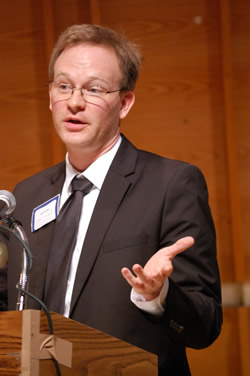
EIRNS/Stuart Lewis
Jason Ross, leader of the LaRouche "Basement" Science Team. |
Jason Ross: Good afternoon! I am very glad to be here. I was going to title my presentation, “Science, as Society’s Unifying Mission,” but in light of the discussion we’ve been having, I think a more appropriate title might be, “We Aren’t Done Yet.” I’ll tell you what I mean by that.
I’d like to discuss the purpose of society as I see it, the purpose of the nation and its role with respect to its individuals, and the role that science plays in that—and use the discussion to incorporate a couple of Mr. LaRouche’s economic principles, discoveries that he had worked on around the year 1950, and which led him to be the most successful economic forecaster today. Those familiar with his history will recall, perhaps as recently as a few years ago, or a decade ago, or go back to the dot.com bubble, that when all the “experts” were saying the dot.com bubble will never pop, LaRouche was right. When people said there would never be another recession, LaRouche was right. Now why was that? Let’s talk about what economics is.
First, the goal of a society goes beyond ensuring the physical well being of its people. I am sure many of you are familiar with the various Freedoms of Franklin Roosevelt, such as the Freedom from Want and the Freedom from Fear. What about the Freedom from Anomie, the Freedom from Uselessness, the Freedom from Wondering Was That a Life Well Lived or Even Worth It At All? The mission that drives individuals, and that they can reflect on at the time of their passing, as having made them necessary and useful persons, comes in part from the decisions that they make, but also in very large degree from the decisions that the society as a whole makes, and the context in which they live out their lives.
For example, during the Apollo program, many components went into the spacecraft. Many of those components were produced with new manufacturing techniques. But I suspect that some of them might have come from the same kind of factory that produced parts for any other application. The people making those parts,— by their being engaged in an endeavor to go to the Moon and do something new for the species as a whole, the value of their work increased, insofar as it was part of that context. So, I want to keep that in mind, in terms of economics.
Potential Population Density
The opportunity to be able to provide citizens, to provide people a life on which they can look back and say that I think this is the highest mission of the nation; it’s the highest mission of society, and it’s one that we can collaborate on with all the other nations, in that it’s a purely affirmative policy. It’s not about superiority. It’s not about maintaining power over others. It’s about “what are we doing that’s new?”
To discuss that, allow me to introduce a concept, “potential population density.” Let me do it by asking a question. Around the world we know of a fair amount of corruption. We know of a fair amount of poor decisions that are being made, some intentional, some through neglect. The pursuit of a war policy by the Obama administration, as Helga has described in great detail, leading towards a confrontation with Russia and China—that’s obviously a bad policy that should be overturned, repudiated.
Let’s say that none of those problems existed. Let’s say that we are running everything as well as we possibly could. The leaders of society are all concerned for people’s well being. We are not stealing from each other. There’s still a limit to how good living standards can be, and it’s determined not just by the way we relate to each other, but by what we know about the world around us.
I want to do this by putting economics in terms of physical chemistry. Think about the number of people that could be supported, or who could live on an acre, or per square kilometer, 5,000 years ago. Let’s say 6 or 7,000 years ago, actually. This is before the use of metals; this is certainly before the use of power sources. There’s a limit. The development of metallurgy 5,000 years ago, the opportunity to take something from the ground, a rock, and turn it into a metal, to make new kinds of tools—that transformed how we were able to live.
Consider the value of the steam engine, which came into major play about 200 years ago. The value of the introduction of the steam engine isn’t something that a Wall Street banker could put a number value on.
The value of a society in which we are able to use chemical energy to create motion—that’s something that transforms who we are. The potential there lies in the difference between physical power and chemical power. So, falling weights, moving around objects—there’s a certain amount of power in that. When you have atoms that are bound together, and you change those atomic bonds, as in burning coal, for example, you can create heat. The heat is able to cause steam to expand and push a piston. You can turn that into motion. You’ve just turned a rock into motion!
What did that enable, in terms of transportation, with the railroads? What did it allow, in terms of production, with manufacturing? What did it allow, in terms of reducing the physical cost of producing goods for people and making them available to a broader part of the population, when they weren’t made by hand or by a water wheel, but could be made by combustion?
Think about the higher level of nuclear power. Many people are scared of nuclear power, for reasons that don’t exist, mainly because they have no understanding of what it means. The nucleus of an atom is bound together—protons and neutrons. By rearranging them, combining nuclei, separating them apart, you release energy. The amount of energy involved in nuclear bonds is a million times beyond what is possible with chemical power! And, it can do different things.
FIGURE 1
Electricity Consumption vs GDP, per capita
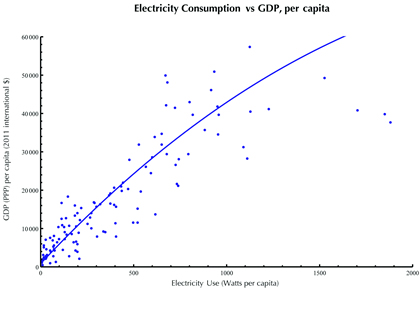 View full size |
Just in terms of the numbers, think about the value to society in being able to mine five pounds of uranium, to provide all the energy needed for a person for a year, compared to 100,000 pounds of coal or oil. What’s the physical cost involved in going through all that coal or oil, compared to those five pounds of uranium?
It’s not just about the amount of energy; it’s about what can you do with it. Let’s look at the first slide (Figure 1). This is a comparison. Gross Domestic Product (GDP) is not the ultimate economic value, but I think this really speaks for itself. Here’s a chart. On the horizontal axis you have energy use per person, in various countries. And on the vertical axis, you have the GDP per person. This makes an obvious statement: Without power, you can’t have improvement in standards of living; without power, you don’t have development. So, the ability to provide that kind of power to people, of course that’s a necessity for what we’re doing.
Necessity of Nuclear Power
Going beyond that, we have to think about the quality of that power. Kesha Rogers referred to the speech that President Kennedy made about going to the Moon. There are other things that he discussed in that speech. There were other proposals that Kennedy made. One of them was for a nuclear rocket.
FIGURE 2
 View full size |
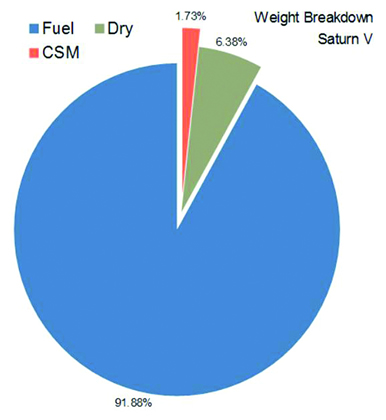 View full size View full size |
Let’s take a look at the next slide. (Figure 2) This is the rocket that went to the Moon, the Saturn V. On the right you see its weight, almost entirely fuel. The dry portion of that pie graph refers to the structure required to hold the fuel. The reddish-orange section is what actually went to the Moon and came back. The rocket’s weight is basically nothing but fuel, if you look at it that way. Certainly we’ve already reached the limits of what we can do in space with chemical propulsion.
FIGURE 3
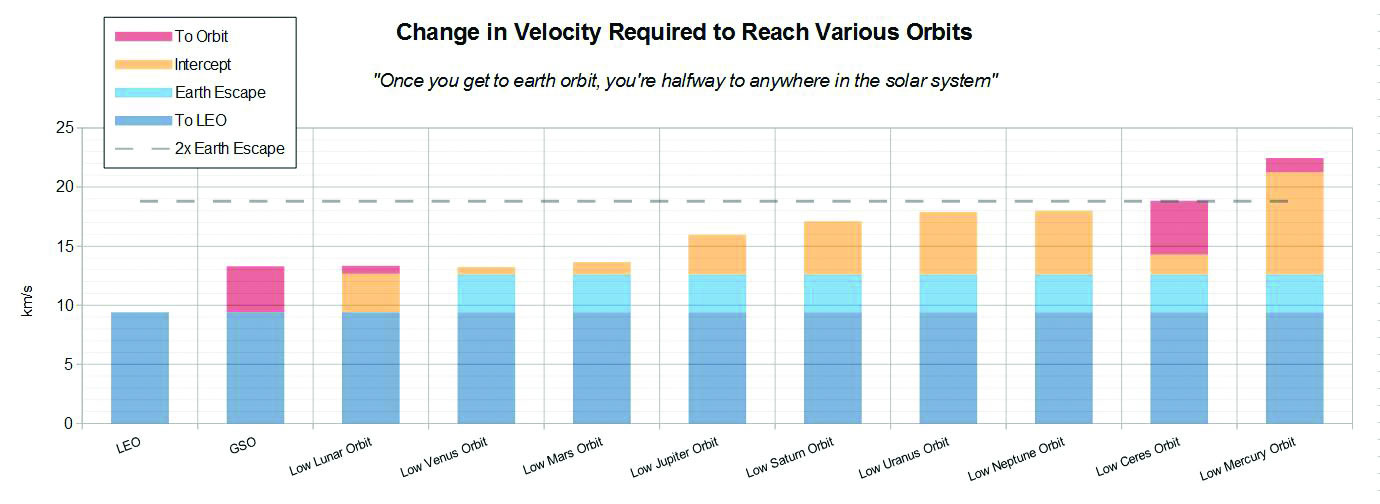 View full size |
Let’s look at the next slide (Figure 3) which shows just the effort of getting off the ground. This is a chart of the amount of energy required to get to various places in the Solar System. The blue bar, which goes up to about nine, that’s just the energy to get up off the ground, to get up off the Earth. Just getting off the Earth is half of what’s required to get anywhere else. Without changes in the way that we relate to space, and how we are able to move around in it, we’re not able to reach the next level.
FIGURE 4
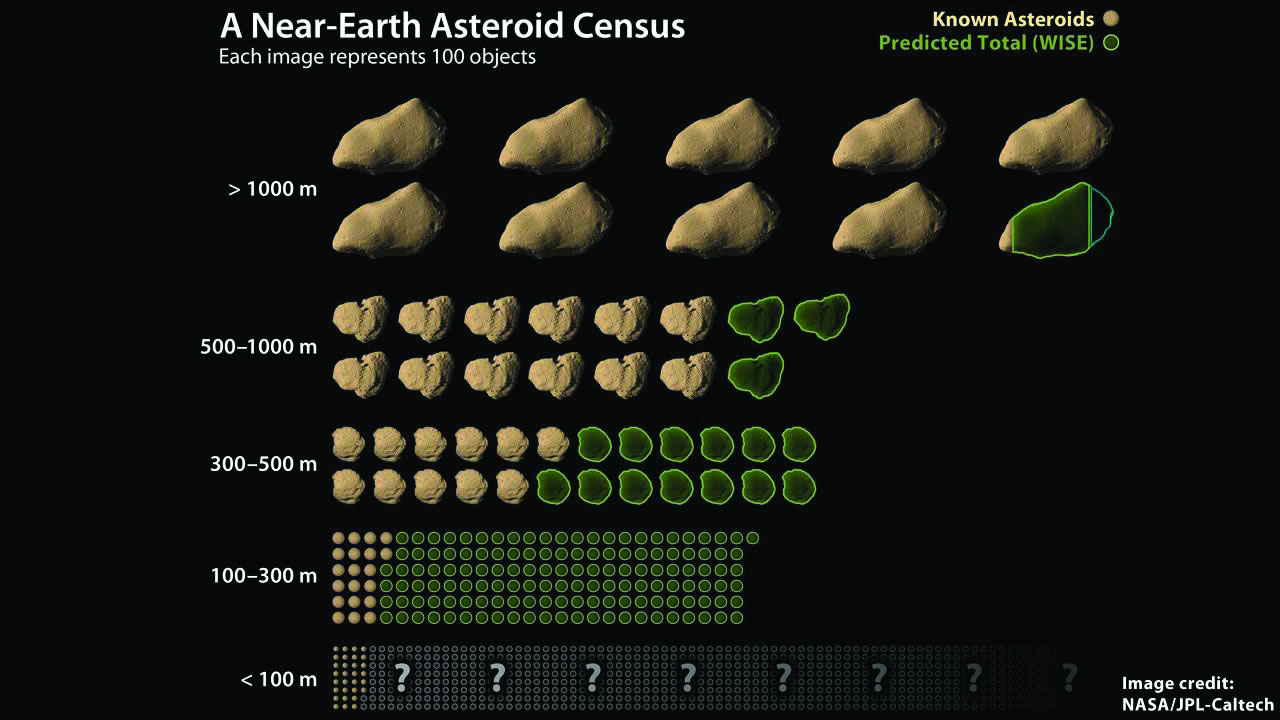 View full size |
Take a look at the next slide. (Figure 4) Here’s an example application. Asteroids strike the Earth. It happens. Eventually, an asteroid of a large enough size to kill everybody will strike the Earth. We’ve got a pretty good indication that it won’t be within the next ten years, but we don’t know where most of these asteroids are. When we find them, if one is coming towards us, we can’t do anything about it if it’s larger than a very, very small one. All we could do would be to evacuate an area that it’s going to hit. How are we going to be able to defend ourselves from threats like this? It is not going to be done with lower-level energy sources; it’s not going to be done with chemical power; it’s not going to be with the low energy-density of solar power. It is going to be done with the kind of intense power that you are able to concentrate by using nuclear fuels.
What Path to Progress?
One of the difficulties in looking at this, is that we think in terms of the present rather than the future. For example, the power required on the planet right now would be over ten times what it currently is, if everyone on the planet had the use of energy and a developing economy to go with it. That is where the United States would be today, had we not had the shift after the assassination of Kennedy, after that shift away from development. Had we not had that shift toward an absolute takeover by the Wall Street idea of value, where money is the measure of value, instead of our physical abilities, U.S. energy use right now would be double what it currently is. Around the world, you are talking ten or twenty times current world levels. The disparity between where we are right now and where we would be if we had we just continued, is enormous. Add in where we ought to be in the future, and it’s absolutely tremendous.
FIGURE 5
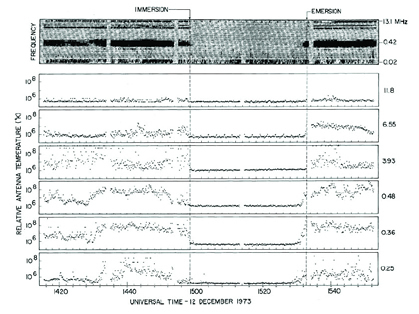 View full size Example of a lunar occultation of the Earth as observed with the upper-V burst receiver of the lunar-orbiting RAE-2 satellite, from Alexander et al. This shows the significance of the terrestrial noise even at the distance of the Moon, and its elimination behind the Moon. |
Who is making that happen? Well, the role of the Chinese space program has been discussed a fair amount here. China, as people know, is the first nation to make a soft landing on the Moon in decades, with the Chang’e lander and the Yutu rover. China is planning, in 2018, to land on the far side of the Moon, something that no nation has ever done. I’ll show you one picture of why that would be useful. (Figure 5) Going from left to right, we have time. This is a fly-by around the far side of the Moon. You can see the intensity of the [ambient] radio waves. Behind the Moon, you can see how low it gets. The only quiet place we’re going to find to do new radio telescope work, to be able to look out and find new things about the universe, is on the far side of the Moon. It’s protected from the Earth.
Think about what we learned with the Laser Interferometer Gravitational-Wave Observatory (LIGO) experiment, and the detection of those gravity waves that were predicted by Einstein 100 years ago. What that represents is a new sense, in terms of the five senses, a new way to “listen” to the universe, a new way to “look” at things. What kinds of further discoveries will that lead to in the future? What will it mean for us to learn more about the quantum world? In a certain way, even the “laws” of thermodynamics aren’t true.
What are the first two laws of thermodynamics? The First Law—untrue—is that the total amount of energy in the universe is fixed. I bet a lot of people think that’s true. When that “law” was passed, in the 1860s, nuclear power didn’t exist. So, with the development of nuclear energy, with Einstein’s E = mc2, you say, “Well, OK, the amount of energy in the universe is still fixed, but now we have the right number; now we’ve figured it out.” Well, are we done? Have we figured everything out? Of course not! We’re not done!
The Second Law of Thermodynamics, that the universe tends towards disorder, that is the popular presentation of it, and the one I want to address: Again, it is not based on doing new things. What I think is important for us to remember in the practice of science, is that we are a force of nature. By discovering principles about how the universe works, and then applying them to cause new things to come about, we act as a force of nature! The mission of society lies in fostering new developments in that way and applying them, and allowing people to participate in that pursuit, whether directly as scientists or, as in the Apollo program, as a whole country, orienting the economy around a commitment to achieving something that led to results that were dramatic for all of mankind.
In reaching these higher levels, going from the world of the Stone Age, to the Bronze Age and the Iron Age, to the Age of the Steam Engine, to the Age of Chemistry—and these days we have a pretty good understanding of chemistry—we are able to create new materials; we’re able to create new resources. We create resources! Uranium is a rock. One of its main uses before nuclear power was discovered, was to tint glass so that it wouldn’t look purple. Now, it makes tremendous amounts of power.
The potential that we have in achieving a greater understanding of the nuclear world, and in having a mastery over the nucleus like the mastery we have to a pretty good degree over chemistry, will open up for us not just a dramatic amount of power, not just a dramatic transformation in our relationship to resources. Consider the use of resources. When we mine ores from the ground, they are rarely in forms that are directly useful to us. When we mine metals, they are basically rust. Iron ore is iron oxide. We have to remove that oxygen; we have to separate it; we have to turn it back into a metal. In doing that, we currently use chemistry. We introduce carbon to suck out the oxygen.
With a fusion torch, with which we are ionizing the atoms themselves and breaking them apart that way, you transform your relationship to materials fundamentally, by which you could—although it might not be effective or reasonable—simply mine dirt. Pass dirt through, separate out the different atoms that make it up. Our relationship to the material world will be transformed; our relationship to the Solar System will be transformed. With a mastery of nuclear rocketry, you could go to Mars and back in a week, as opposed to taking months and months and months, as today.
These are not things that we know how to do right now. They are things that we’re getting closer towards. Fusion research, in particular, has been so underfunded over the past decades, that it has to represent an intention not to make that breakthrough.
Zeus and Prometheus
Why anyone would want to do that? Why is there opposition, for example, to the Land-Bridge? That’s maybe not so hard to gauge. We have the Project for the New American Century and the idea that “American military supremacy must remain unchallenged.” We’ve got the Wall Street/City of London control over finance, threatened by a different turn in the economy. Why would a scientific breakthrough itself be opposed?
I will finish with an example of that, the Greek story of Prometheus. People are probably familiar with it. Prometheus saved mankind from being completely eliminated by Zeus, the king of the gods. Beyond that, Prometheus overturned one of Zeus’s edicts. Zeus, he needed a therapist; he needed something to do with himself. Zeus, the King of Olympus, said that fire was only for him; it was not for the use of mortals. His identity lay in his superiority to them. If human beings developed, what would his identity be anymore? So, he said, “Forget it! It’s forbidden!”
Prometheus, another one of the gods, took fire from Zeus and gave it to mankind. For this Zeus punished him, chained him to a rock. An eagle ate out his liver every day. He underwent torment. But, as the story goes, he gave mankind fire, poetry, astronomy, an understanding of the calendar for agriculture, the use of animals to do our tasks for us, medicine, number. He made us human.
That basis of our humanity, that fire in its various forms, that discovery of new sources of power through new understanding of the universe around us, that ability to transform who we are, and in so doing to really be ourselves in a scientifically cultural way—well, that is what makes us human. It is also under attack. We see that today, with the attack on the provision of power, as we heard in the message to the conference from Dr. Kelvin Kemm of South Africa, on the disgusting idea promoted by some visitors, saying, “Oh, Africans don’t really need power; it’s not their culture.”
Poverty Is Intentional
People are people. The idea of “appropriate technologies” is completely reprehensible. But it exists today: preventing power from reaching people, preventing the development of the economy, using wars and conflict to prevent development, to break up the potential for the Silk Road, for example. As Sen. Dick Black went through, the instability in Syria is being deliberately promoted by the policies of the U.S. government—what’s the point? What is the point of creating chaos?
In a sense, the fight over developing a scientific culture for the nation, the fight over developing a purpose for the nation, for society, for cooperation among nations, it stands up against some very major enemies. In promoting those principles you start to find out about those enemies. But in doing this, we always develop higher steps. We’ve never been done! We never will be. Our current resource base is a stepping stone to the future.
Imagine, before the introduction of the steam engine, if we had said, “We’ve got to save our wood resources.” Wood was a very limited resource in the 1600s and earlier. What saved the wood, what saved the forests? Coal! Right! Coal, yes, it’s limited, but we are certainly a fair way off from reaching its limit. But we have to use these resources that we currently have, towards achieving the next higher levels. For us today that would mean a major emphasis on fusion, on nuclear research—as nuclear research—to develop a mastery over that domain of nature that we don’t currently have. It will provide us power; it will provide us transportation potentials, the ability to move through the Solar System and have a better control over it, to defend ourselves from asteroids; and it will transform our resource base and our relationship to raw materials.
There is no reason for poverty to exist anywhere in the world right now! The fact that it does, is a result of a political intention for it to exist. We certainly know how to grow food, we know how to provide power. But we shouldn’t limit ourselves to the alleviation and elimination of poverty.
Where we ought to be, is so far ahead of where we are right now, that it is stunning. By creating cultural institutions in a society by which we are oriented towards developing to those higher levels, we provide people, each other, ourselves, an opportunity to live a life that we can look back on and say that the future will have judged it to have been necessary.
